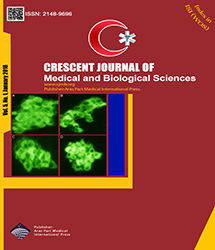| Original Article | |
| Non-alcoholic Fatty Liver Disease and its Predictive Factors Among High-Risk Employees of Health Insurance Organization in Tabriz, Iran | |
| Saeed Jodi1, Azizeh Farshbafkhalili2, Reza Nikanfar3, Leila Javadi4 | |
| 1East Azerbaijan Heaith Insurance Organization, Tabriz, Iran 2Physical Medicine and Rehabilitation Research Center, Midwifery Department, Tabriz University of Medical Sciences, Tabriz, Iran 3Department of Health Education and Promotion, Tabriz University of Medical Sciences, Tabriz, Iran 4Nutrition Research Center, Student Research Committee, Tabriz University of Medical Sciences, Tabriz, Iran |
|
|
CJMB 2018; 5: 034-039 Viewed : 4899 times Downloaded : 4427 times. Keywords : Prevalence, Predictive factors, NAFLD |
|
| Full Text(PDF) | Related Articles | |
| Abstract | |
Objective: Non-alcoholic fatty liver disease (NAFLD) has been known as the most frequent type of liver disease, with the occurrence of 20% to 30% in developed countries and 33.9% in Iran. In this study, we aimed to evaluate the prevalence of fatty liver among high-risk individuals and its predictive factors. Materials and Methods: This analytic cross-sectional study was performed on 70 men and women, aged 32–62 and BMI ≥25, who were divided into 2 groups: 1) the patient group (n = 45) with positive results of fatty liver disease, and 2) the healthy group (n = 25). An anthropometry assessment (weight and BMI), blood tests (AST, ALT, FBS, TC, and TG), and determination of fatty liver grade were done. Results: In our study, the rate of NAFLD was 64 among 100 susceptible individuals (BMI ≥25). We found significant differences in sex (P = 0.020), weight (P < 0.001), BMI (P = 0.001), AST (P<0.001), ALT (P < 0.001), and AST/ALT (P < 0.025) between the groups. A direct association was observed between the increase in BMI and NAFLD (P = 0.001). In the study of relationship between fatty liver grade, BMI, and biochemical factors, there were significant differences in mean BMI, weight, AST, ALT, and AST/ALT between patients with NAFLD grades 1 and 3. However, no significant changes were observed for FBS, TC, and TG between patients with NAFLD grades 1, 2 and 3. Sex, BMI and AST were estimated as independent predictors of NAFLD. The risk of NAFLD increased in male sex (P = 0.053), by the increment of BMI (P = 0.002) and AST (P = 0.002) in the study. Conclusion: This study verified the relationship between NAFLD and obesity, and liver aminotransferase was repeatedly reported in NAFLD. |
Cite By, Google Scholar
Google Scholar
PubMed
Online Submission System
 CJMB ENDNOTE ® Style
CJMB ENDNOTE ® Style
 Tutorials
Tutorials
 Publication Charge
Medical and Biological Research Center
About Journal
Publication Charge
Medical and Biological Research Center
About Journal
Aras Part Medical International Press Editor-in-Chief
Arash Khaki
Deputy Editor
Zafer Akan


















